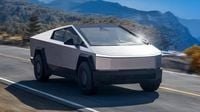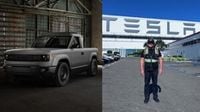On August 26, 2025, the electric vehicle scene in South Korea took a dramatic leap forward as Tesla Korea officially launched the much-anticipated Cybertruck. The futuristic pickup, which first turned heads globally in 2019, has now landed on Korean soil with a fanfare befitting its bold, angular design and cutting-edge technology. According to Herald Economy, the launch event at Incheon International Airport drew significant attention, not least because K-pop superstar G-Dragon was spotted arriving in a Cybertruck at a recent Chanel event, setting social media abuzz and fueling local excitement.
The Cybertruck is available in two trims for the Korean market: the AWD (all-wheel drive) and the high-performance Cyberbeast. Both variants come equipped with Tesla’s signature ultra-hard stainless steel exoskeleton and reinforced glass, giving the vehicle its distinctive, almost sci-fi appearance. As Financial News reports, the AWD model is priced at approximately 145 million Korean won, while the Cyberbeast comes in at 160 million won. The vehicles are set to be revealed to early reservation holders from August 29 to September 4, with general pre-orders opening on November 4, 2025.
Performance is where the Cybertruck really flexes its muscles. Despite tipping the scales at a hefty 3.9 tons, the Cyberbeast trim, powered by a tri-motor setup, rockets from zero to 100 km/h in just 2.7 seconds—a figure that would make many sports cars blush. The standard AWD model, with its dual motors, isn’t far behind, boasting a top speed of 180 km/h, while the Cyberbeast pushes that limit to 209 km/h. Both trims offer two battery options, with estimated ranges of 520 km and 496 km on a single charge, though Tesla Korea notes that these figures are subject to final government certification.
The Cybertruck is not just about brute force and speed. Tesla has packed it with practical features aimed at making it a versatile, premium leisure EV. For the first time in a Tesla vehicle, the Cybertruck supports Vehicle-to-Load (V2L) technology, which allows owners to use the truck as a mobile power source—ideal for camping trips or emergency situations. The truck’s adaptive air suspension system, capable of adjusting damping in milliseconds, promises a smooth ride regardless of terrain, while the massive 3400-liter cargo space and a towing capacity approaching five tons make it a true workhorse. The battery can be fully charged in about five hours, ensuring minimal downtime between adventures.
Inside, the Cybertruck continues its theme of innovation and individuality. The interior is marked by sharp, geometric lines, a minimalist console, and uniquely designed cup holders, all reinforcing the truck’s futuristic identity. Tesla’s ‘steer-by-wire’ system, which enables the large vehicle to turn with less than 340 degrees of steering input, ensures that maneuverability is not sacrificed for size—a detail that’s sure to please drivers navigating Korea’s busy urban environments.
According to Electimes, the Cybertruck is only the second Tesla model to be officially introduced in South Korea, following the Model Y. Since its global debut, the truck has attracted a steady stream of domestic reservations, reflecting strong local demand for electric pickups that blend performance, utility, and a dash of celebrity allure. Tesla Korea shared, “Since the first unveiling in 2019, the Cybertruck has recorded high pre-order rates in Korea, raising expectations not just as a simple pickup truck but as a premium leisure EV.” The company expects the first deliveries to begin in late November 2025.
But Tesla isn’t the only company making moves in the electric pickup space. On the very same day as Tesla’s announcement, Slate Auto—a US-based EV startup backed by Amazon founder Jeff Bezos—revealed that it had completed its first production Cybertruck at its Warsaw, Indiana plant. As reported by M Today, Slate Auto has been developing its own electric pickup since 2020 and has attracted more than $700 million in investment, with Bezos among its high-profile backers. The company has aggressively recruited top talent, including Napoleon Reyes, a Purdue-trained mechanical engineer and former Marine who previously led the Model Y assembly line at Tesla’s Fremont factory.
Reyes, who recently returned to his Indiana roots to be closer to family, expressed his excitement about the new role: “I had a meaningful time participating in various line expansions and the Model Y program launch at Tesla over about five years. Now, I’m starting a new challenge in my hometown of Indiana to be closer to my family.” Slate Auto’s manufacturing team is a who’s who of automotive expertise, featuring veterans from Subaru, Ford, and Tesla. Rich Schmidt, another former Tesla executive, currently heads up manufacturing at the company.
Slate Auto’s first production Cybertruck mirrors the specs of Tesla’s Korean launch: two battery options with ranges of 520 km and 496 km, a weight of 3.9 tons, zero-to-100 km/h acceleration in 2.7 seconds, and V2L technology with a 3400-liter equivalent external power supply. The company plans to start official pre-orders on September 29, 2025, with prices ranging from 45 million to 60 million Korean won, directly targeting the same market segment as Tesla.
The electric pickup market is heating up, and industry observers are watching closely to see how these two players—one an established giant, the other a nimble upstart—will shape the future of automotive transportation in Korea and beyond. With both companies boasting deep pockets, seasoned engineers, and ambitious production goals, consumers are the ultimate winners, gaining access to vehicles that push the boundaries of technology, design, and utility.
As the Korean EV landscape shifts, the Cybertruck’s blend of performance, innovation, and pop culture cachet is poised to make a lasting impression. Whether you’re a die-hard Tesla fan, a tech-savvy early adopter, or just someone who appreciates a head-turning ride, the arrival of the Cybertruck signals that the future of driving in Korea is anything but ordinary.


